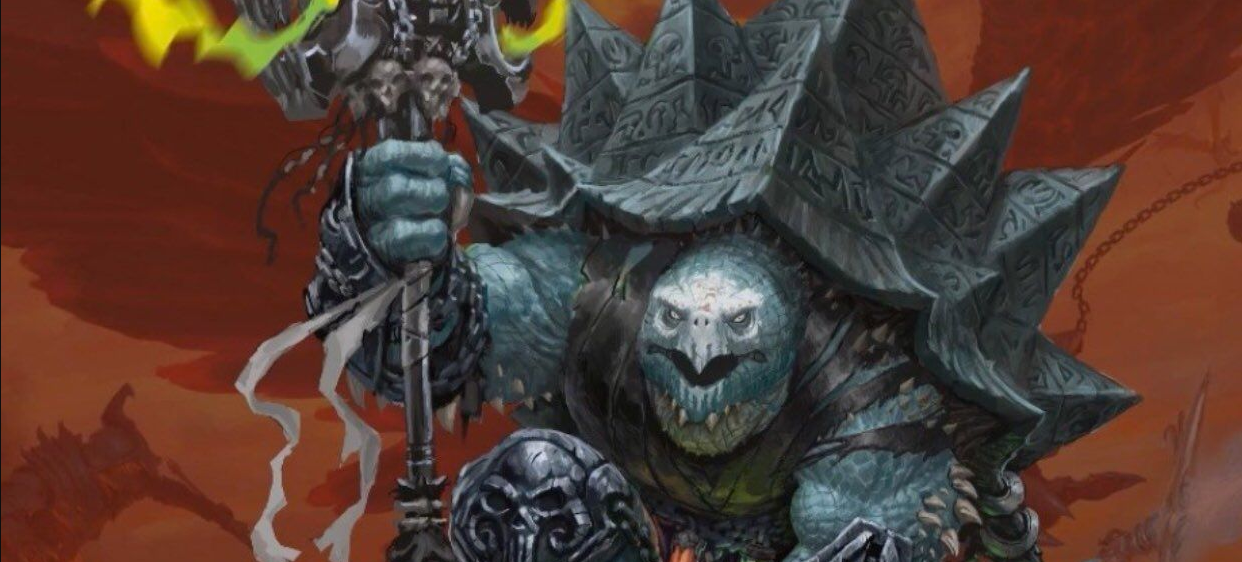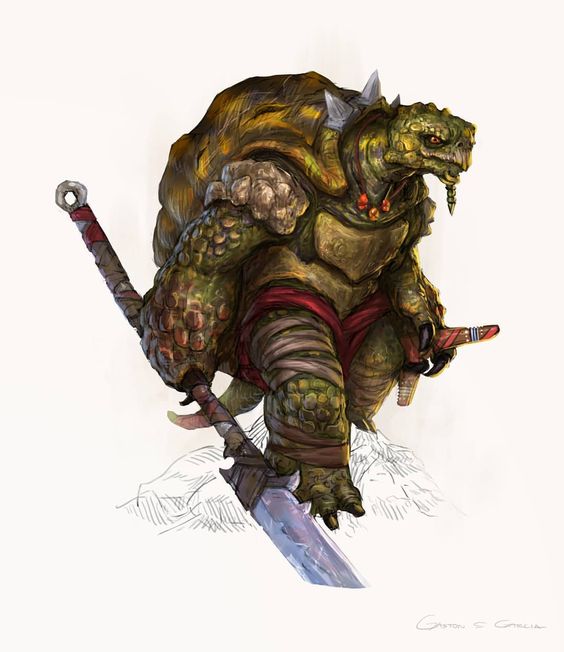Amphibian Heritage
Also known as tortles
Tortles are (c) Wizards of the Coast.
What many tortles consider a simple life, others might call a life of adventure. Tortles are born near sandy coastlines, but as soon as they’re able to walk on two legs, they become nomad survivalists eager to explore the wilderness, experience its many wonders, put their skills to the test, and make new acquaintances.
Basic Information
Tortles have a large, knobby shell that encases most of their body and into which they can withdraw their extremities. Their hands and feet have hard, semi-sharp claws primarily used for digging. Some tortles have beak-like mouths while others have softer faces. Most tortles have a very short, stubby tail. Tortles are completely hairless.
All tortles are at once asexual and hermaphroditic. Any tortle can impregnate any other tortle. Tortles lay leathery eggs 2 to 3 months after being fertilized, which mature over another 8 or 9 months before hatching. Tortles lay clutches of 1 to 12 eggs at a time.
A tortle hatches from a thick-shelled egg and spends the first few weeks of its life crawling on all fours. Its parents, old and near death, spend what little time they have left telling stories to their offspring. Within a year, the young tortle becomes an orphan, though not before it learns to speak and to survive on its own.
When a tortle nears the end of its natural lifespan, it seeks out a mate and procreates.
Tortles are pescaterian, subsisting on diets of leafy greens and fleshy fruits along with seafood.
Additional Information
Tortles lay their eggs (numbering as few as one or as many as a dozen) in a fortified compound enclosed by stone walls that are easily defensible. If no such compound exists, they build one. The parents spend the remainder of their lives guarding the compound, defending their offspring, and sharing a lifetime of knowledge before they die. When the children are old enough to leave the compound, they pick up whatever weapons and tools their parents left behind and set out on their own.
Tortles have a saying: “We wear our homes on our backs.” The shells they carry around provide all the shelter they require. Consequently, tortles don’t feel the need to root themselves in one place for too long. A tortle settlement is primarily used as a kind of moot, where tortles can socialize with one another, share useful information, and trade with strangers in the safety of greater numbers. Tortles don’t regard these settlements as places worth defending with their lives, and they will abandon a settlement when it no longer serves their needs.
Civilization and Culture
Tortles prefer simple, non-gender-specific names that are usually no more than two syllables. If a tortle doesn’t like its name for whatever reason, it can change it. A tortle might change its name a dozen times in its life.
Tortles don’t have surnames or family names.
Tortle Names: Baka, Damu, Gar, Gura, Ini, Jappa, Kinlek, Krull, Lim, Lop, Nortle, Nulka, Olo, Ploqwat, Quee, Queg, Quott, Sunny, Tibor, Ubo, Uhok, Wabu, Xelbuk, Xopa, Yog
Tortles only have a single gender, thus gender ideals boil down to personal preference in shell shape, pattern, and personality.
Tortle courtship is blunt and simple. A tortle looking for a mate will simply ask another if they are interested. If so, the two are in a lifetime relationship together.
Although for most of their lives tortles feel no need for romantic companionship or procreation, once they reach a quarter of a millenia their biological clocks tick on and kickstart this drive for them. Tortles that mate are then monogamous mates for the rest of their lives.
Most tortles like to see how other creatures live and discover new customs and new ways of doing things. The urge to procreate doesn’t kick in until the end of a tortle’s life, and a tortle can spend decades away from its native land without feeling homesick. Tortles embrace a simple view of the world. It is a place of wonder, and tortles see beauty in the ordinary. They live for the chance to hear a soft wind blowing through palm trees, to watch a frog croaking on a lily pad, or to stand in a crowded human marketplace.
Tortles like to learn new skills. They craft their own tools and weapons, and they are good at building structures and fortifications. They marvel at the works of other civilized creatures, humans in particular, and can lose themselves for years in a city, studying its architectural wonders and learning skills they can put to use when building forts to contain their offspring.
Although they spend a considerable portion of their lives in isolation, tortles are social creatures that like to form meaningful friendships. They have no inbred animus toward people of other races. In fact, a tortle will often seek out friendships with non tortles to learn new customs and new points of view.
Once the tortles began appearing from the ancient gaians, their outlook on life changed drastically. Feeling that their hardiness was a gift that should be put to use, they one and all appointed themselves guardians against the return of the Elder Things, making their homes on the world's wilderness coasts and honing their vigil through constant patrols.
Since that long-ago time tortles have always existed, yet are almost completely unknown. It has only been in the last few dozen years that tortles have begun to venture into the cities of other species as their eons-long guardianship has been slowly forgotten over time, leading more and more of them to travel the world.
Tortles believe that night and day watch over them and other creatures. The moon is the eye of night that watches over them in darkness, and the sun is the equally vigilant eye of day. Tortles feel most at peace when one or both of these “eyes” are looking down on them. They become more nervous and uneasy when neither orb is visible in the sky. Tortles tend to be most uncomfortable underground, where neither the sun nor the moon is visible to them.
Blessed are the days when both the sun and moon are visible in the sky at the same time. Tortles often choose such days to leave their homes and begin a wilderness expedition, or perform some other task they know to be dangerous.
Scientific Name
Homo farrago testudo
Lifespan
Tortles mature by age 15 and can live up to 300 years.
Average Height
5 to 6 feet
Average Weight
450 to 600 lbs (a third of their weight is their shell)



Comments